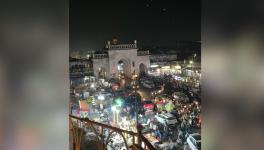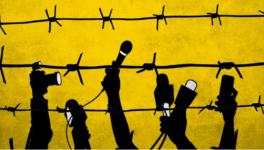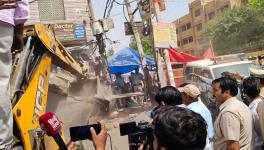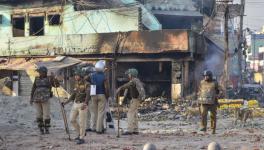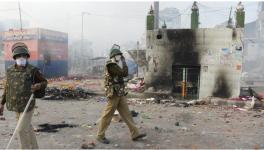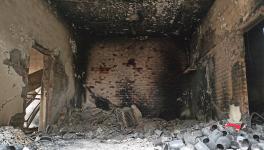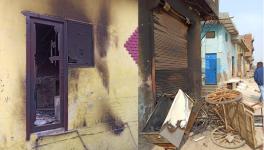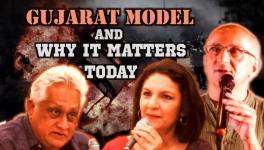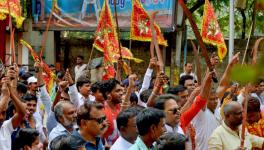North-East Delhi: Where Galis Now Lead to Gates
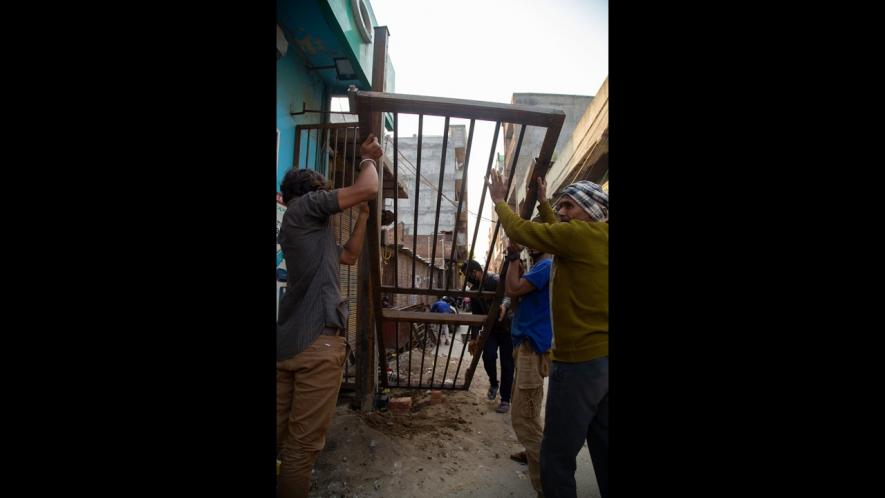
Image by Tanushree Bhasin
Borders within and borders without dominate conversation in North-east Delhi. The mini partitions in the offing in the aftermath of the communal violence, like the original in 1947, are marked by trauma and loss.
In Babu Nagar, the atmosphere is tense at Hari Singh Solanki’s house as relatives trickle in to pay respects to Rahul Solanki, his son who was shot dead in the recent violence. “He had just gone out to fetch milk. Within 15 minutes of his leaving the house we got a call that he had been shot,” says Solanki.
The house stands at the junction of a fork in the road, one of the lanes that veers off is described by the mourners as “unki gali”—their, meaning Muslim’s, lane. Babu Nagar in Mustafabad has predominantly Muslim residents with scattered galis where Hindu families reside. Suraj Bhan, 60, a resident of adjacent Shiv Vihar is one of the visiting relatives at this house who says he was hit with stones on 24 February. He takes me through Brijpuri, to Shiv Vihar, pointing out several parts of the locality struck by violence. Small-scale construction work appears to be on at entrances to various galis: “We are erecting metal gates here,” he says.
“We are collecting money from the neighbourhood and getting these gates put up between our lanes and their lanes. We have to protect ourselves,” explains Bhan. At most places the basic frame of a gate has been cemented in so far. “We are waiting for the cement to dry so we can finish the work. Bigger gates will be put up close to the main road,” he says.
“They were fully prepared with all kinds of weapons whereas we were caught completely off guard. Hindu families are so docile you won’t even find a stick in our houses. How could we have fought them?” he adds. As he points out more gates cropping up in the Shiv Vihar area, he dismisses questions about the scale of violence against Muslims and insists that the attack was planned in Shaheen Bagh and executed here. “They basically want to make a Shaheen Bagh in every colony, that’s their plan.”
In the aftermath of the violence, there is a sense of persecution and vulnerability within the Hindu community. The fact that a majority of the violence was directed against Muslim persons and property appears not to have registered with the local Hindu residents. “More Hindus have died, Muslims are only inflating the numbers because they want the government’s compensation,” says a 54-year-old government servant and resident of Brijpuri, who did not want to be identified. “We will put up gates between our areas and their ‘Pakistan’,” he says.
Ramesh, 30, who owns a small metalworks shop in Brijpuri Gali no. 1 has been tasked with the job of making metal gates to be put up in the neighbourhood. “I have received orders for at least 10 gates, all in Brijpuri itself. We just want to make sure our galis are safe,” he says. Two workers were busy welding iron rods to get the jobs done quickly.
Lines seem to have been drawn on the land and in language. The binary of “us” and “them” appears to have been dosed with more vitriol, so much so that cultural differences now appear as offensive rejections of the idea of the nation. “Why do these people have to study in madrasas, why can’t they study in regular schools like us? They are not Indians,” says Dori Lal, 49, a relative of Suraj Bhan.
On the other side of this imagined divide, Muslim neighbourhoods too are installing gates. Work is on in gali no. 7 of Old Mustafabad to erect a metal gate at the main road from where the gali spirals in. “We have a mosque in this gali and we want to make sure that it is protected. That is why we are putting up this gate,” says Hassan, an elderly resident.
There was, amidst the tumult, a central element to the violence; that of wounded and distressed families fleeing for cover. Now as some young men from one of the afflicted zones lifts a heavy iron gate into place, I ask Hassan if these gates will affect relations between the communities, “We will keep this gate open at all times. It is not meant to stop people from going in. This is only for emergencies when we are under attack,” he explains.
As both communities try to restrict entry in their neighbourhoods—albeit for different reasons—the process of segregation and alienation seems to have begun in an area that is otherwise not a ghetto.
Gates don’t simply keep people out; they also box you in.
Most of the stories of Hindus and Muslims helping each other during the Delhi riots have come from mixed neighbourhoods. When you know your neighbours, it is that much harder to think of them as the “other”. When your only understanding of the “other” is the one supplied by the media, rumour and propaganda—and not based on personal interactions—spreading hate becomes that much easier. The gates are a physical manifestation of this wedge between communities, of imagined and real persecutions, created with a very particular ideological purpose in mind.
Meanwhile, for Hari Singh Solanki, after the loss of his son, his house is no longer home. “We don’t plan to live in Babu Nagar anymore. We don’t feel safe here.”
The author is a freelance journalist. The views are personal.
Get the latest reports & analysis with people's perspective on Protests, movements & deep analytical videos, discussions of the current affairs in your Telegram app. Subscribe to NewsClick's Telegram channel & get Real-Time updates on stories, as they get published on our website.










